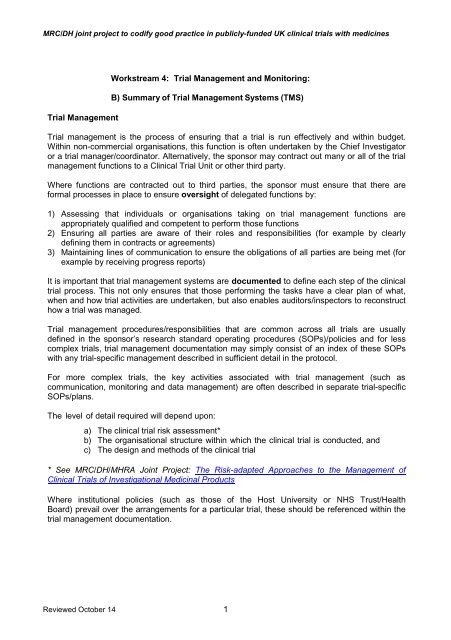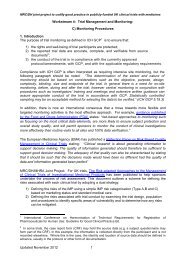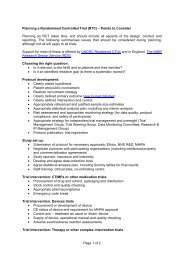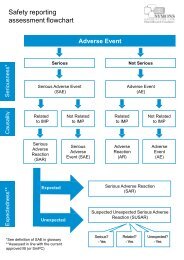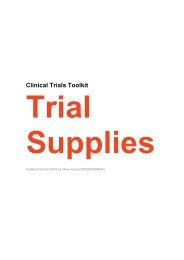Summary of Trial Management Systems Workstream Document
Summary of Trial Management Systems Workstream Document
Summary of Trial Management Systems Workstream Document
Create successful ePaper yourself
Turn your PDF publications into a flip-book with our unique Google optimized e-Paper software.
MRC/DH joint project to codify good practice in publicly-funded UK clinical trials with medicineson the nature <strong>of</strong> the trial.For trials involving advanced therapies, any additional arrangements for safety reporting shouldbe described.Other points to consider include trial-specific arrangements outlining out-<strong>of</strong>-hours cover withdetails <strong>of</strong> arrangements for trial team access in the event <strong>of</strong> an emergency and details <strong>of</strong>emergency code break if applicable.The Pharmacovigilance <strong>Workstream</strong> <strong>Document</strong> provides comprehensive guidance on all aspects<strong>of</strong> the pharmacovigilance process.Endpoint AssessmentThis should outline the methods for assessing study endpoints, e.g. independent review,endpoint adjudication committee, procedures for assessing images, pathology samples, etc.Writing <strong>of</strong> Reports and PublicationsArrangements for authorship and mechanisms for dissemination <strong>of</strong> results should be described.Computer <strong>Systems</strong>Computer systems used in clinical trials should be developed and maintained to a standardappropriate to their functionality within the trial. Particular attention should be paid to issues <strong>of</strong>confidentiality, validation, security and access to data.For some trials it may be necessary for computer systems to meet external standards such asthe United States Code <strong>of</strong> Federal Regulations Chapter 21 Part 11 (21 CFR Pt. 11) .The procedure for developing and maintaining computer systems should be described inan appropriate level <strong>of</strong> detail, with reference to external standards, if applicable. For example,sections on security, user specification, development process, validation methods, bug-reportingand disaster recovery may all be relevant. The change control process should be fullydocumented from the date <strong>of</strong> change request; date <strong>of</strong> release <strong>of</strong> amended version and any form<strong>of</strong> impact assessment associated with the changes where appropriate.System validation should also be demonstrable for Interactive Voice/Web Response <strong>Systems</strong>used for activities such as randomisation, trial supply and blinding/unblinding.For complex systems it is likely that these will need to be addressed in separate documents,which should be cross-referenced.Data <strong>Management</strong>The following should be defined: The identity and location <strong>of</strong> all source documents: For example when the case report form(CRF) can be the source data and when a separate source document (<strong>of</strong>ten the subject’smedical records) will be used. N.B. Source data may be held on electronic data entrysystems (e.g. electronic patient record systems or electronic case report forms). See <strong>Trial</strong><strong>Document</strong>ation station for expectations in relation to source data. The CRF/database development process: The design <strong>of</strong> the CRF and trial databaseincluding who will be involved in the review and approval process. Further guidance onDeveloping a Case Report Form can be found on the CT Toolkit. It is <strong>of</strong>ten useful toinclude the ‘end user’ to help identify any problems with the design <strong>of</strong> the CRF and toensure that the order in which data are captured aligns with clinical practice.The location, change control and release procedures for all key data managementdocumentation should be described. The data flow: How data will be integrated into the trial database (e.g. from paper orelectronic CRFs, patient diaries, central laboratories). Data checking/query process: The level (percentage) and method <strong>of</strong> data entry checkingshould be defined (e.g. for logical consistency, missing or implausible data or protocoldeviations). Methods could include data entry printout comparison with the CRF, checkinga sample <strong>of</strong> data, double data entry, range value checks, checks for missing data.A predefined ‘acceptable error rate’ with actions to be taken if the error rate is exceeded,should be set.Plans for making corrections (including self-evident corrections) and the tracking <strong>of</strong> queriesso that additions and corrections made to the CRFs and the database can be tracked andReviewed October 14 6
MRC/DH joint project to codify good practice in publicly-funded UK clinical trials with medicinesexplained in a clear audit trail.It is important to specify the process for defining, capturing, and assessing GCP/protocolnon-compliances so that any significant non-compliance can be identified for inclusion inthe Clinical Study Report.The process for confirming when the database is ‘clean’ and considered final and theconfirmation <strong>of</strong> when/how it is formally locked must be clear.How the database will be stored, accessed and protected (from editing or deletion), forexample, the process for restricting or removing edit rights, should be described.Investigational Medicinal Product <strong>Management</strong>The following aspects may be relevant and are dealt with in more detail in the <strong>Trial</strong> Suppliesstation: Source <strong>of</strong> study drug (including comparator or placebo) Procedures for manufacture, packaging, labelling and distribution Accountability at site(s) Disposal <strong>of</strong> unused study treatmentOutline details <strong>of</strong> the management <strong>of</strong> the randomisation systems (telephone, web-based, fax,etc.) and blinding/unblinding procedures to be used.Statistical AnalysisIdentify those responsible for statistical analysis and documentation <strong>of</strong> the statistical analysisplan (see Statistical Data Analysis station).Regulatory SubmissionsIf appropriate, describe who will be making the submission, and the arrangements for preparingdata for submission and answering regulatory queries.ArchivingOutline procedures for archiving all study documentation including the <strong>Trial</strong> Master File, casereport forms and other essential documents and any arrangements with investigator sites for thearchive <strong>of</strong> the Investigator Site File and source data to comply with relevant regulations. (seeArchiving station).Outline procedures and timelines for storage/destruction <strong>of</strong> biopsies, tissue samples, geneticmaterial, etc.Additional Reading: A Guide to Efficient <strong>Trial</strong> <strong>Management</strong> (<strong>Trial</strong> Managers’ Network).Updated in November 2012: T Symons Associates LtdReviewed October 14 7


